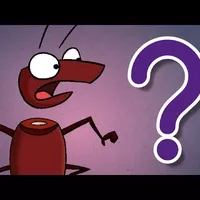¿Las cucarachas pueden vivir sin cabeza? - Especial de Halloween / Día de muertos
||||||||Halloween|||
|||||||||||Toten
|cockroaches||||head|||Halloween|||dead
||||||||Halloween|||
|karaluchy|||bez|głowa||||||
Können Kakerlaken ohne Kopf leben? - Halloween / Tag der Toten Spezial
Can cockroaches live without a head? - Halloween Special / Day of the Dead
Les cafards peuvent-ils vivre sans tête ? - Spécial Halloween / Jour des morts
Gli scarafaggi possono vivere senza testa? - Speciale Halloween / Giorno dei morti
ゴキブリは頭がなくても生きられるのか?- ハロウィーン/死者の日特集
Kunnen kakkerlakken leven zonder kop? - Halloween / Dag van de Doden Special
Czy karaluchy mogą żyć bez głów? - Halloween / Dzień zmarłych - specjalne
As baratas podem viver sem cabeça? - Especial Dia das Bruxas / Dia dos Mortos
Могут ли тараканы жить без головы? - Хэллоуин / День мертвых
Kan kackerlackor leva utan huvuden - Halloween / Day of the Dead Special
Hamamböcekleri kafaları olmadan yaşayabilir mi? - Cadılar Bayramı / Ölüler Günü Özel
Gián có thể sống mà không có đầu không? - Chuyên đề Halloween / Ngày của những người chết
Y ahora ¡una historia de terror! ¡La cucaracha sin cabeza!
|||||Horror||||
And||||of|terror|The|cockroach|without|head
Und nun eine Horrorgeschichte: die kopflose Kakerlake!
that can be disturbing or disgusting. We recommend caution. A story of horror. THE HEADLESS COCKROACH
Ve şimdi korku hikayesi! Başsız hamam böceği!
Và bây giờ, ¡một câu chuyện kinh dị! ¡Con gián không đầu!
Son famosas por su tenacidad y resistencia pero
||||sự kiên trì|||
||||Tenazität||Widerstand|
They are||||tenacity|and||
||||sebat|||
||||wytrwałość|||
Sie sind für ihre Zähigkeit und Widerstandsfähigkeit bekannt, aber
They're famous for their tenacity and resilience,
Dayanıklılıkları ve dirençleri ile ünlüdürler ama
Chúng nổi tiếng vì sự kiên cường và sức chịu đựng nhưng
¿Es cierto que las cucarachas pueden vivir sin cabeza?
Is|true|||cockroaches|can|||
||||karaluchy||||
Stimmt es, dass Kakerlaken ohne Kopf leben können?
but, is it true that cockroaches can live without their heads?
Hamam böceklerinin başsız yaşayabileceği doğru mu?
Có đúng là gián có thể sống mà không cần đầu không?
Bueno, y aunque la pregunta parezca tonta
|and|||question|seems|silly
Nun, und auch wenn die Frage albern erscheinen mag
Well, even if the question seems dumb,
İyi, ve soru saçma gibi gelse de
Thì, dù câu hỏi nghe có vẻ ngớ ngẩn
¿por qué los humanos nos morimos si perdemos la cabeza?
|||||||mất||
for|||||die|if|lose||
|||||umieramy||||
Warum stirbt der Mensch, wenn er den Kopf verliert?
why do humans die if we lose our heads?
Neden insanlar kafayı kaybedersek ölürüz?
tại sao con người chúng ta lại chết nếu mất đầu?
En primer lugar por la pérdida de sangre:
In|||for|the|loss||blood
Vor allem wegen des Blutverlustes:
First of all because of the blood we lose,
İlk olarak kan kaybı nedeniyle:
Đầu tiên là do mất máu:
la herida sería tan grande que nos desangraríamos, y sin sangre, ni el oxígeno ni los nutrientes podrían llegar a nuestros órganos.
|||||||||||||oxi||||||||
the|wound|would be|||that||we would bleed out|and|||neither||oxygen|or||nutrients|could||||
|||||||kanarız||||||||||||||
|rana||||||wykrwawialibyśmy||||||||||||||
Die Wunde wäre so groß, dass wir verbluten würden und ohne Blut könnten weder Sauerstoff noch Nährstoffe in unsere Organe gelangen.
the wound would be so big, we would bleed out. And without blood neither oxygen nor nutrients
Yara o kadar büyük olurdu ki kan kaybederdik ve kan olmadan ne oksijen ne de besin maddeleri organlarımıza ulaşabilirdi.
vết thương sẽ lớn đến nỗi chúng ta sẽ bị mất máu, và không có máu, cả oxy lẫn chất dinh dưỡng sẽ không thể đến được các cơ quan của chúng ta.
Además de que en la cabeza tenemos la nariz y la boca, el cerebro controla la mayor parte de las funciones de nuestro cuerpo
||||||||||||||kiểm soát|||||||||
In addition||||||||||||||controls|||||||||
Zusätzlich zu der Tatsache, dass wir im Kopf die Nase und den Mund haben Das Gehirn steuert die meisten Funktionen unseres Körpers,
could get to our organs. Besides having our mouth and nose on our heads,
Başımızda burun ve ağız olmaktan başka, beyin vücudumuzun çoğu fonksiyonunu kontrol eder.
Ngoài việc ở đầu chúng ta có mũi và miệng, não bộ kiểm soát hầu hết các chức năng của cơ thể chúng ta
y sin cerebro no podríamos movernos ¡ni respirar!
|||||di chuyển||
|without||no||move||breathe
und ohne Hirn könnten wir uns nicht bewegen oder atmen!
the brain controls most of our body's functions and without the brain, we are not able to control
Ve beyin olmadan hareket edemezdik, nefes bile alamazdık!
và không có não chúng ta không thể di chuyển! Cũng không thể thở!
¡Y sin respiración no hay oxígeno para vivir!
||breath|||oxygen||
Und ohne Atmung gibt es keinen Sauerstoff zum Leben!
And without breathing, we wouldn't have oxygen to live.
Ve nefes almadan yaşamaya yetecek oksijen yok!
Và nếu không có hơi thở thì không có oxy để sống!
Pero las cucarachas no tienen este problema: no respiran por la cabeza.
||||||||hô hấp|||
||cockroaches||||||breathe|||
||karaluchy||||||oddychają|||
Aber Kakerlaken haben dieses Problem nicht: Sie atmen nicht durch ihren Kopf. Wie alle
But cockroaches don't have this problem, they don't breathe through their heads,
Ama hamam böceklerinin böyle bir problemi yok: başlarıyla nefes almazlar.
Nhưng gián thì không có vấn đề này: chúng không thở bằng đầu.
Como todos los insectos, respiran a través de pequeños orificios que tienen por el cuerpo llamados “espiráculos”,
|||||||||lỗ|||||||
||||||||||||||||Spirakel
Like|||insects|breathe||through||small|holes|that||||||spiracles
||||||||||||||||trakea delikleri
|||||||||otworów|||||||spirakle
Insekten atmen durch winzige Löcher in ihrem Körper, die
Insects breathe through small holes in their bodies called
Tüm böcekler gibi vücutlarında 'spirakül' adı verilen küçük deliklerden nefes alırlar.
Giống như tất cả các loài côn trùng, chúng hô hấp qua những lỗ nhỏ trên cơ thể gọi là “lỗ thở”
que llevan el oxígeno directamente a sus tejidos.
|||||||mô tế bào
|||||||Gewebe
that|||oxygen|directly|to||tissues
|||||||tkankach
die den Sauerstoff direkt zum Gewebe transportieren.
They get the oxygen directly into their tissues.
oksijeni doğrudan dokularına taşıyan.
cung cấp oxy trực tiếp đến các mô của chúng.
¿Y la sangre? Los insectos no tienen sangre, sino hemolinfa, que es bombeada por este curioso corazón.
|||||||||Hämolymphe|||gepumpt||||
And|||The|insects|||blood|but|hemolymph|that||pumped||||heart
|||||||||hemolimf|||pompalanır||||
|||||||||hemolimfa|||pompowana||||
Was ist mit Blut? Insekten haben kein Blut, sondern Hämolymphe, die von diesem seltsamen Gefäß gepumpt wird.
And the blood? Insects don't have blood; they have hemolymph, which is pumped
Peki ya kan? Böceklerin kanı yoktur, ama bu ilginç kalp tarafından pompalanan hemolenf vardır.
Còn máu thì sao? Côn trùng không có máu mà có huyết thanh, được bơm bởi trái tim kỳ lạ này.
Aunque es muy importante para su vida, la presión interna es mucho menor que la de los humanos,
|||||||||nội bộ||||||||
Although|||||your||the||||||||||
Obwohl es sehr wichtig für Ihr Leben ist, ist der Innendruck viel niedriger als der Innendruck des Herzens des Menschen,
by this weird heart, and though it's very important for keeping them alive, their internal pressure is much lower
Hayatları için çok önemli olmasına rağmen, iç basınç insanlarinkinden çok daha düşüktür.
Mặc dù nó rất quan trọng cho cuộc sống của chúng, nhưng áp lực bên trong thấp hơn nhiều so với con người,
así que no se les “sale el mole” a chorros como a los vertebrados
|||||||||dòng||||
|||||||Mole||||||
so|||||spills||sauce|a|jets||||vertebrates
|||||||mole||strumienie||||kręgowce
|||||||mole||chorros||||
Das bedeutet, dass sie ihr Muttermal nicht wie Wirbeltiere "ausspritzen".
than that of humans, so they don't suffer hemorrhages like vertebrates do,
niż ludzie, więc nie "wypryskują swojego kreta", jak robią to kręgowce.
bu yüzden kamburlar gibi akmıyor
vì vậy không có hiện tượng “chảy máu” mạnh như ở động vật có xương sống,
y sus heridas se cierran antes de desangrarse. Si a esto le añadimos que el cuerpo de la
||vết thương|||||||||||||||
and|their|wounds||close|||bleed out|If||||we add|||body||
|||||||kan kaybetmek||||||||||
||rany|||||wykrwawić się||||||||||
und seine Wunden schließen sich, bevor er verblutet. Hinzu kommt die Tatsache, dass der Körper des
and their wounds close up before bleeding out. If we also add that a cockroach's body
ve yaraları kan kaybetmeden önce kapanıyor. Buna ek olarak
và vết thương của chúng sẽ lành lại trước khi mất máu. Nếu thêm vào đó rằng cơ thể của
cucaracha puede continuar moviéndose y respondiendo a estímulos externos porque esas reacciones
|||di chuyển||||||||
|||en se déplaçant||répondant||||||
cockroach|can||moving||responding||stimuli|external|||reactions
|||||||Reizen|äußeren|||
karaluch|||poruszając się||||bodźce||||
Die Schabe kann sich weiterhin bewegen und auf äußere Reize reagieren, da diese Reaktionen
cockroach can continue to move and respond to external stimuli because those reactions
sivrisinek vücudu dışarıdan gelen uyarılara yanıt vermeye ve hareket etmeye devam edebilir çünkü bu tepkiler
gián có thể tiếp tục di chuyển và phản ứng với các kích thích bên ngoài vì những phản ứng đó
no dependen de su cerebro ¡una cucaracha zombi sin cabeza puede seguir merodeando por
|||||||zombi|||||errant|
||||||cockroach|zombie||head||to keep|loitering|
||||||||||||lảng vảng|
|||||||Zombie-Kakerlake|||||herumstreunen|
|||||||zombi|||||dolaşmak|
|||||||zombie|||||merdować|
nicht auf ihr Gehirn angewiesen sind - eine kopflose Zombie-Kakerlake kann immer noch auf der Lauer liegen
A zombie, headless cockroach can still roam around your home
Beyinlerine bağlı değildir! Başsız bir zombi hamamböceği hâlâ dolaşmaya devam edebilir.
không phụ thuộc vào não của nó! Một con gián zombie không đầu có thể tiếp tục lang thang quanh
tu casa hasta por una semana! Entonces, como no puede comer ni beber, moriría simplemente
|||||||||||||sẽ chết|
|||||||||||||je mourrais|
|||||||||||||sterben würde einfach|
|||||||||||||would die|
|||||||||||||umarłby|
Ihr Haus für bis zu einer Woche! Da er dann weder essen noch trinken kann, würde er einfach sterben.
for almost a week. Then, since it can't eat or drink, it would simply die of thirst,
evinde bir haftaya kadar! O zaman, ne yiyip ne de içebilir, sadece susuzluktan ölürdü.
nhà bạn đến cả tuần! Vì vậy, vì không thể ăn uống, nó sẽ chết đơn giản
de sed. Si tuviera manera de hidratarse, podría vivir sin comida hasta por un mes.
|жидкость|||||гидратироваться||||||||
|sed (1)|||||s'hydrater||||||||
|thirst|If|had|||to hydrate oneself|could|||||||
||||||tưới nước||||||||
||||||Wasser trinken||||||||
||||||nawodnić się||||||||
durstig. Wenn sie eine Möglichkeit hätte, sich selbst mit Flüssigkeit zu versorgen, könnte sie bis zu einem Monat ohne Nahrung auskommen.
If it had a way of hydrating itself, it could live without food for nearly a month,
Eğer su almak için bir yolu olsaydı, yiyecek olmadan bir aya kadar yaşayabilirdi.
vì khát. Nếu có cách nào để cung cấp độ ẩm, nó có thể sống mà không cần thức ăn đến một tháng.
¿Y la cabeza? Esa también puede seguir viva..
|||||||lebendig
||head|That||||alive
Und der Kopf? Der kann auch noch lebendig sein...
But what about the head?, you may wonder
Peki ya kafa? O da hayatta kalmaya devam edebilir.
Còn cái đầu? Nó cũng có thể sống tiếp...
por unas cuantas horas
for|||
für ein paar Stunden
It can also remain alive for a few hours.
trong vài giờ
¡Curiosamente!
Seltsam!
It can also remain alive for a few hours.
Thú vị làm sao!

